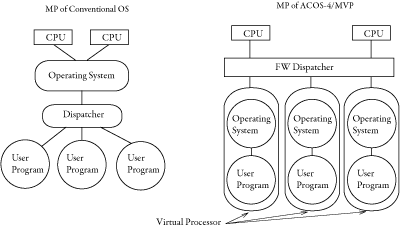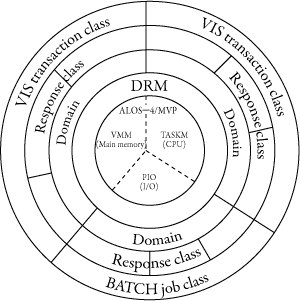NEC started shipping ACOS-4/MVP (Multi Virtual Processor) in July 1979.
ACOS-4/MVP was an operating system for large and super-large machines that was developed under a concept consistent with the operating system ACOS-4 for medium-sized machines, which had been shipped earlier, and maintained upper compatibility. It achieved higher performance than ACOS-4 in basic system control; for example, by changing the virtual memory method and improving the system parallel processing. It also realized core functions for use by multiple users, such as interactive processing and an online processing package. This OS was installed in medium-to-large machines, System 450 and System 550, and super-large machines, System 800, System 750 and System 950.
Features of the newly adopted architecture and of major functions were as follows.
1.Features of the Architecture
(1) Adoption of a virtual memory method based on paged segmentation
This method combined segmentation and the paging mechanism, and divided segments with two-dimensional addresses into equal-length blocks, which were pages. ACOS-4/MVP adopted a 2-KB page size. It increased memory utilization by defining several page statuses and performing detailed memory management.
(2) Adoption of dynamic address conversion
Even if the CPU did not convert the logical address in the channel program to the actual address, the I/O processor directly executed the channel program written in the logical address. This increased efficiency of I/O processing in a large-scale system.
(3) Strengthened system parallel processing with multiple processors
ACOS-4/MVP was capable of simultaneously executing multiple tasks and achieved a high level of parallelism. This increased parallelism through distribution of the operating system's processing (OS operated in extension of a user task), and the virtual processor concept of mapping the hardware architecture of the multiprocessor system further increased parallel operability. In addition, the processes of ACOS-4/MVP were multiplexed in order to increase the performance in system tasks.
 figure 1
figure 1 In ACOS-4/MVP, most routines of the operating system were changed to reentrant routines, and processes were ultimately distributed in order to maximize the capacities of multiple processors.
2.Features of the Functions
(1) Interactive information processing (time-sharing system)
The OS enabled the user to easily develop a system and perform operations such as data search/report creation while interacting with the central system from a remote terminal. Thus, the terminal users were able to use the center computer as if they were occupying it. NEC provided PWSS (Personal Work Station System) for medium-sized systems, and ATSS (Advanced Time Sharing System) for large systems.
(2) DB/DC package that supported establishment of online real-time processing
This was an online database system that was systematically managed as a database required for business processing and used simultaneously by multiple remote terminals, and it realized online control of multiple tasks and journal/recovery control that had previously created by the user with VIS (Versatile Information System) as part of the OS.
(3) Increased throughput and response performance by DRM (Dynamic Resource Manager)
DRM was designed to perform control for achieving target performance in response to various dynamic load changes by centrally managing system resources used in various facilities such as interactive information processing, online processing and batch processing, which operated with the system. It improved performance and response as well as system processing capacity.
DRM controlled allocation of resources (memory size, I/O device, CPU) by dividing jobs running on the system into groups (called domains), and managed the target response time and the target achievement ratio for each of the response classes, which were subdivisions of a domain. Response classes were mapped into ATSS command class for interactive information processing, VIS transaction class for online processing and job class for batch processing, to allow allocation of services according to the characteristics of specific operations.
 Figure 2
Figure 2(4) Protection of confidential information through user management and resource user management
The OS realized user management with UAF (User Administration Facility) in which users of the system were registered in advance, processing patterns to permit use of interactive information processing and DB/DC were set for each user, and the user was checked when he/she actually used the system. In addition, permissions to access files were set for each user, and prevention of access infringement due to misunderstanding or malevolence was achieved with RUAF (Resource and User Administration Facility).
(5) Support of bases for fault tolerant facilities of software
For ACOS-4/MVP, NEC took measures to minimize the impact of software failure on operation, such as recovery at a function/process level and localization of the failure point, in addition to an alternative CPU recovery function of the multiprocessor configuration system and a hardware-based RAS function that included automatic system restart in the event of system failure.
NEC built the following three bases for recovery in order to prevent abnormal termination of processes/jobs and stop of the whole system in the event of software failure.
|
Exceptional processing EXIT |
User could incorporate routines that were performed in the case of an exceptional event due to software failure. |
| Function recovery procedure |
Designed to recover mainly the basic OS functions, it defined the scope and method of recovery according to the purpose and implementation method of the function. |
| Process recovery procedure |
Designed to attempt recovery of a process in conditions where process abort resulted, such as failure in the above two recovery procedures, it defined recovery closed to a single process. |



